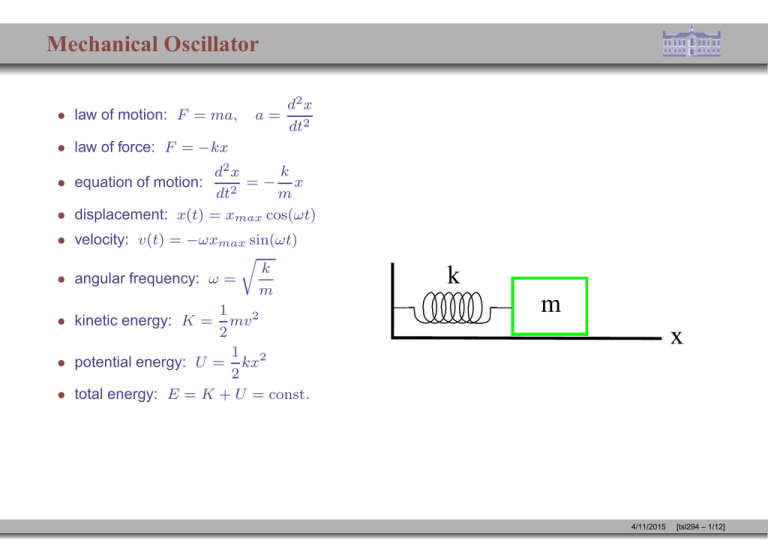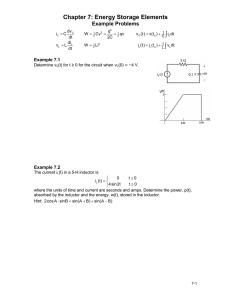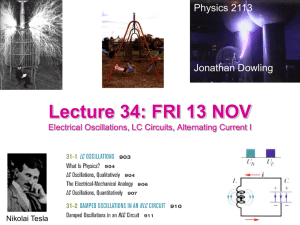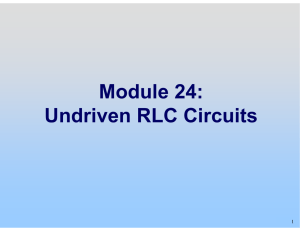Mechanical Oscillator
advertisement

Mechanical Oscillator • law of motion: F = ma, d2 x a= 2 dt • law of force: F = −kx k d2 x x = − • equation of motion: dt2 m • displacement: x(t) = xmax cos(ωt) • velocity: v(t) = −ωxmax sin(ωt) r k • angular frequency: ω = m 1 • kinetic energy: K = mv 2 2 1 • potential energy: U = kx2 2 • total energy: E = K + U = const. k m x 4/11/2015 [tsl294 – 1/12] Electromagnetic Oscillator ( LC Circuit) Q dI dQ +L = 0, I = C dt dt d2 Q 1 • equation of motion: Q = − dt2 LC • charge on capacitor: Q(t) = Qmax cos(ωt) • loop rule: • current through inductor: I(t) = −ωQmax sin(ωt) • angular frequency: ω = √ • magnetic energy: UB = 1 LC 1 2 LI 2 (stored on inductor) L C Q2 • electric energy: UE = (stored on capacitor) 2C • total energy: E = UB + UE = const. 4/11/2015 [tsl295 – 2/12] Mechanical vs Electromagnetic Oscillations mechanical oscillations • position: x(t) = A cos(ωt) [red] • velocity: v(t) = −A sin(ωt) [green] r k 2π , ω= • period: τ = ω m +A • potential energy: U (t) = 1 2 kx (t) [r] 2 1 mv 2 (t) [g] 2 • total energy: E = U (t) + K(t) = const • kinetic energy: K(t) = E 0.25 0.5 0.75 1. tΤ -A 0.25 electromagnetic oscillations • charge: Q(t) = A cos(ωt) [red] • current: I(t) = −A sin(ωt) [green] • period: τ = 2π , ω ω= √ 1 LC 0.5 0.75 1. tΤ 1 2 Q (t) [r] 2C 1 • magnetic energy: UB (t) = LI 2 (t) [g] 2 • total energy: E = UE (t) + UB (t) = const • electric energy: UE (t) = 4/11/2015 [tsl497 – 3/12] Mechanical Oscillator with Damping • law of motion: F = ma, xHtL d2 x a= 2 dt dx dt d2 x k b dx • equation of motion: + x=0 + dt2 m dt m • law of force: F = −kx − bv, v= t vHtL t Solution for initial conditions x(0) = A, v(0) = 0: (a) underdamped motion: b2 < 4km » x(t) = Ae−bt/2m cos(ω ′ t) + b sin(ω ′ t) ′ 2mω – ′ with ω = s b2 k − m 4m2 (b) overdamped motion: b2 > 4km » x(t) = Ae−bt/2m cosh(Ω′ t) + b ′ sinh(Ω t) 2mΩ′ – ′ with Ω = s k b2 − 4m2 m 4/11/2015 [tsl299 – 4/12] Damped Electromagnetic Oscillator (RLC Circuit) QHtL dI Q dQ + = 0, I = • loop rule: RI + L dt C dt d2 Q 1 R dQ • equation of motion: + Q=0 + dt2 L dt LC t IHtL Solution for initial conditions Q(0) = Qmax , I(0) = 0: (a) underdamped motion: R2 < Q(t) = Qmax e 4L C −Rt/2L (b) overdamped motion: R2 > t » R cos(ω t) + sin(ω ′ t) ′ 2Lω ′ – with ′ ω = s R2 1 − LC 4L2 4L C » Q(t) = Qmax e−Rt/2L cosh(Ω′ t) + R ′ sinh(Ω t) 2LΩ′ – ′ with Ω = s 1 R2 − 4L2 LC 4/11/2015 [tsl300 – 5/12] LC Circuit: Application (1) Name the LC circuit with the highest and the lowest angular frequency of oscillation. L L L (1) (2) C L C C L L (3) C C C L L (4) C C 4/11/2015 [tsl296 – 6/12] LC Circuit: Application (2) At time t = 0 a charge Q = 2C is on each capacitor and all currents are zero. (a) What is the energy stored in the circuit? (b) At what time t1 are the capacitors discharged for the first time? (c) What is the current through each inductor at time t1 ? 2H 2H 2H (1) (2) 2F 2H (3) 2F 2H 2F 2F 2H 2F 2F 2H 2H 2F (4) 2F 4/11/2015 [tsl297 – 7/12] LC Circuit: Application (3) In these LC circuits all capacitors have equal capacitance C and all inductors have equal inductance L. Sort the circuits into groups that are equivalent. (1) (2) (3) (4) (5) (6) (7) (8) 4/11/2015 [tsl298 – 8/12] Oscillator with Two Modes a Electromagnetic: Q Q dI dQ dI + + +L = 0, I = dt C C dt dt 2 dI Q d Q 1 2 √ ⇒ =− ⇒ = −ω Q, ω = dt LC dt2 LC mode #1: L b a dI Q 2Q dQ + + = 0, I = dt C C dt r 3Q d2 Q 3 dI 2 =− ⇒ = −ω Q, ω = ⇒ dt LC dt2 LC mode #2: L b Mechanical: mode #1: ω = r k m mode #2: ω = r 3k m k k m k m 4/11/2015 [tsl498 – 9/12] RLC Circuit: Application (1) In the circuit shown the capacitor is without charge. When the switch is closed to position a... (a) find the initial rate dI/dt at which the current increases from zero, (b) find the charge Q on the capacitor after a long time. Then, when the switch is thrown from a to b... (c) find the time t1 it takes the capacitor to fully discharge, (d) find the maximum current Imax in the process of discharging. 12V 5mH 4Ω 20nF a b 4/11/2015 [tsl438 – 10/12] RLC Circuit: Application (2) In the circuit shown the capacitor is without charge and the switch is in position a. (i) When the switch is moved to position b we have an RL circuit with the current building up gradually: I(t) = (E/R)[1 − e−t/τ ]. Find the time constant τ and the current Imax after a long time. (ii) Then we reset the clock and move the switch from b to c with no interruption of the current through the inductor. We now have a an LC circuit: I(t) = Imax cos(ωt). Find the angular frequency of oscillation ω and the maximum charge Qmax that goes onto the capacitor periodically. 34V 6.2 µ F 14Ω b a c 54mH 4/11/2015 [tsl499 – 11/12] RLC Circuit: Application (3) In the circuit shown the capacitor is without charge and the switch is in position a. (i) When the switch is moved to position b we have an RC circuit with the capacitor being charged up gradually: Q(t) = EC[1 − e−t/τ ]. Find the time constant τ and the charge Qmax after a long time. (ii) Then we reset the clock and move the switch from b to c. We now have a an LC circuit: Q(t) = Qmax cos(ωt). Find the angular frequency of oscillation ω and the maximum current Imax that flows through the inductor periodically. 34V 14Ω 6.2 µ F b 54mH c a 4/11/2015 [tsl500 – 12/12]





